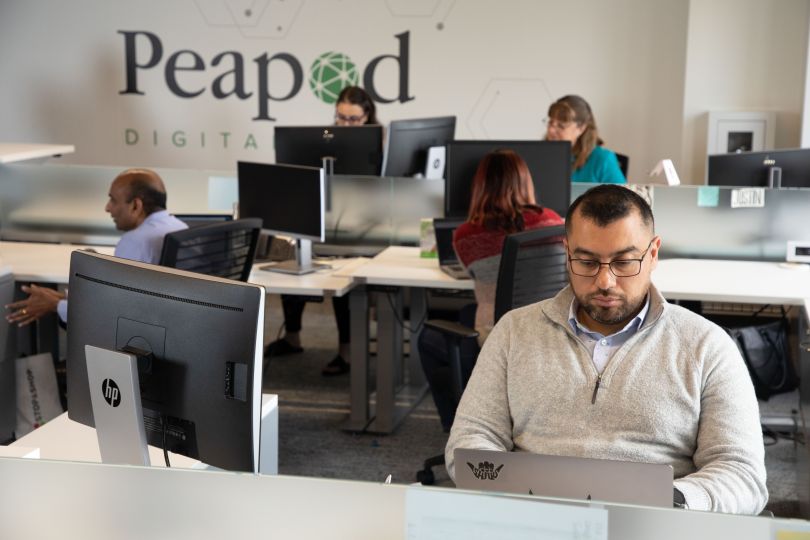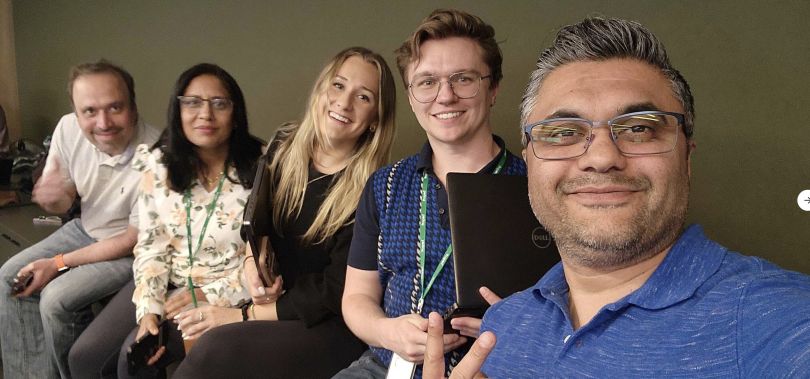Paul Yang believes building a brand new native app is kind of like orchestrating the “Big Bang.”
“All existing critical functionalities need to be in place on the first day of launch,” he explained.
As director of mobile engineering at Ahold Delhaize USA, a company that partners with grocery retailers to develop omnichannel experiences, Yang played a key role in building the company’s recently launched native app. To ensure the critical functionalities were ported and functioning correctly, he relied on close-knit collaboration among Ahold Delhaize USA’s product and tech team members.
This level of teamwork is nothing new for Yang and his teammates. He considers the work they do each day a “process of endless optimizations,” which helps them overcome the countless hurdles that stand in their way.
“In the engineering world, there are new challenges every day — from implementation to production support,” Yang said. “We exchange our knowledge and experiences, and we support each other to meet a common goal: delivering the best omnichannel grocery shopping experience for our customers.”
This common goal catalyzed the company’s decision to create the app, which was designed to provide an enhanced and seamless user experience — one that would outshine that of the PRISM React Native app that was developed in 2017.
By conducting user interviews and analyzing app reviews, Associate Product Manager Hannah Michalek and her colleagues realized that the company’s customers wanted features and functionalities that were unique to native apps and prevalent in other popular apps.
“This revelation motivated us to go beyond merely replicating the existing React Native app and focus on elevating the user experience with innovative, native-specific features,” she said.
Ahold Delhaize USA’s decision to build a native app is part of a larger industrywide shift toward mobile. According to Product Lead Mahesh Sahni, consumers’ demand for mobile usage is increasing due to its accessibility, convenience and value: three characteristics that the company’s new app offers.
“The native mobile experience will enhance customer engagement, boost revenue and improve operational efficiency for grocery brands while providing a personalized, time-saving and value-driven shopping experience for customers,” he said.
The creation of the app involved leveraging the latest technologies, overcoming challenges and encountering “aha!” moments. When combined, all of these elements unlocked valuable growth opportunities for team members, including Sahni, who has learned many leadership lessons as a result of this latest project and his time at the company as a whole.
“I’ve been fortunate to be part of this project and work with a team of skilled people, including some of the best leaders in the business,” he said. “It has been an enlightening journey thus far.”
WHY NATIVE?
There’s a reason Ahold Delhaize USA sought to create a native digital app. According to Sahni, native digital apps are “the core of digital transformation and acceleration,” shaping the customer experience roadmap for various omnichannel capabilities, including enhanced payment methods — think Apple Pay and PayPal — and convenience features, such as curbside pickup. “Building these features natively in iOS and Android allows us to provide higher performance and faster loading by utilizing the bandwidth of the operating systems,” he added.

Building a Seamless Experience
Yang acknowledges that building a seamless omnichannel shopping journey is never easy. It requires intensive creative thinking, the design of both online and offline shopping experiences and rigorous integrations across multiple services.
That’s why Yang and his peers utilized a selection of tools that would allow them to deliver intuitive, responsive experiences when building the app. Leveraging Swift and Kotlin, his team was able to use a native UI framework to bring the best interactive app user experience. GraphQL allowed them to easily tailor the API response and consolidate multiple API calls into one in order to boost app content loading.
Sahni added that Figma enabled efficient design iterations and collaboration, while JIRA supported their teams with task tracking, sprint planning and seamless coordination among team members. Those involved in the project also integrated Google Analytics and Firebase Analytics to enhance the user experience and track performance, and integrated monitoring and alerting tools such as Crashlytics and Datadog to maintain app stability and performance.
“This allowed us to proactively identify and address issues, thereby ensuring a smooth and reliable user experience,” Sahni said.
But even a tech stack as powerful as this one can’t prevent challenges from popping up at times. Sahni said he and his peers encountered several obstacles throughout the project, including limited access to resources as a result of the pandemic.
To counteract this issue, they built relationships with third-party vendors who were able to fast-track the code development and testing process, which required a stringent quality-control process. Sahni explained that hiring skilled developers, product managers and UX designers required rigorous assessment — but ultimately, their support proved highly advantageous.
“Introducing change agents for fresh perspectives was essential to our success, as their insights and adaptation to industry practices fueled innovation,” he said.
THE PROCESSES BEHIND THE PROJECT
To bring the new native app to life, Ahold Delhaize USA’s tech and product teams collaborated closely on a daily basis. According to Yang, four mobile teams were tasked with different areas of the project. Key members of each team met daily to discuss their tickets, while managers from each team met daily to discuss issues and progress. Developers conducted quick tech design reviews to think through requirements and find existing codes for reuse, and they reviewed UX flows to ensure all potential conditions were covered.
Yang added that the teams also relied heavily on an agile approach. He said developers, managers and product owners were trained across all functions on the foundation of sprint, scrum, kanban and extreme programming. The mobile engineering team conducted biweekly meetings to share topics about agile, system architecture, mobile analytics and more. “This was done in an effort to get our developers ready to not only deliver new mobile experiences, but also understand customer behaviors so we can address UX enhancements and prioritize mission-critical features in a weekly and biweekly release cadence,” Yang explained.

Major Growth Moments
Ahold Delhaize USA’s most recent product launch was the culmination of years of innovation, collaboration and overcoming challenges. But for Michalek, it was even more than that — it was one of the biggest growth moments in her career.
“I learned to adapt to change, handle challenges with agility and prioritize effectively,” she said. “Moreover, working closely with various teams taught me valuable communication and collaboration skills that are essential for leading a successful product launch.”
Throughout the project, Michalek had the chance to lead the development and implementation of key features while offering mentorship and support to product analysts and co-ops. Given how much she evolved during this experience, she’s eager to see what other projects she and her peers get to tackle.
“Although it was a challenging endeavor, I’m immensely proud of the work we’ve accomplished as a team,” Michalek said. “I’m excited about the future and the continued growth of our products and company.”
“I’m excited about the future and the continued growth of our products and company.”
Yang also gained many skills while developing the app, including learning how to help his teammates access the resources they need to overcome obstacles. He believes the work that went into the project is a reflection of the strength of his peers and the supportive culture they’ve cultivated together.
“I’m lucky to work with a talented group of product and tech team members,” Yang said. “We learn together, brainstorm together and celebrate our achievements together.”
From a leadership standpoint, Sahni played a pivotal role in launching the app, leveraging his background in the grocery retail industry to steer the teams involved and maintain alignment. But aside from the technicalities that go into launching a new product, he discovered what it truly means to be a people leader.
“I discovered the significance of empathy, recognizing that understanding team members’ perspectives improves morale and motivation,” Sahni said.
While he learned many lessons, such as the importance of progress over perfection and doing more with less, he considers the greatest one to be embracing failure — a nod to the company’s overarching focus on a “fail fast and learn fast” mentality.
Sahni concluded, “I found that empowering the team to innovate, experiment and take calculated risks created a culture of growth.”








